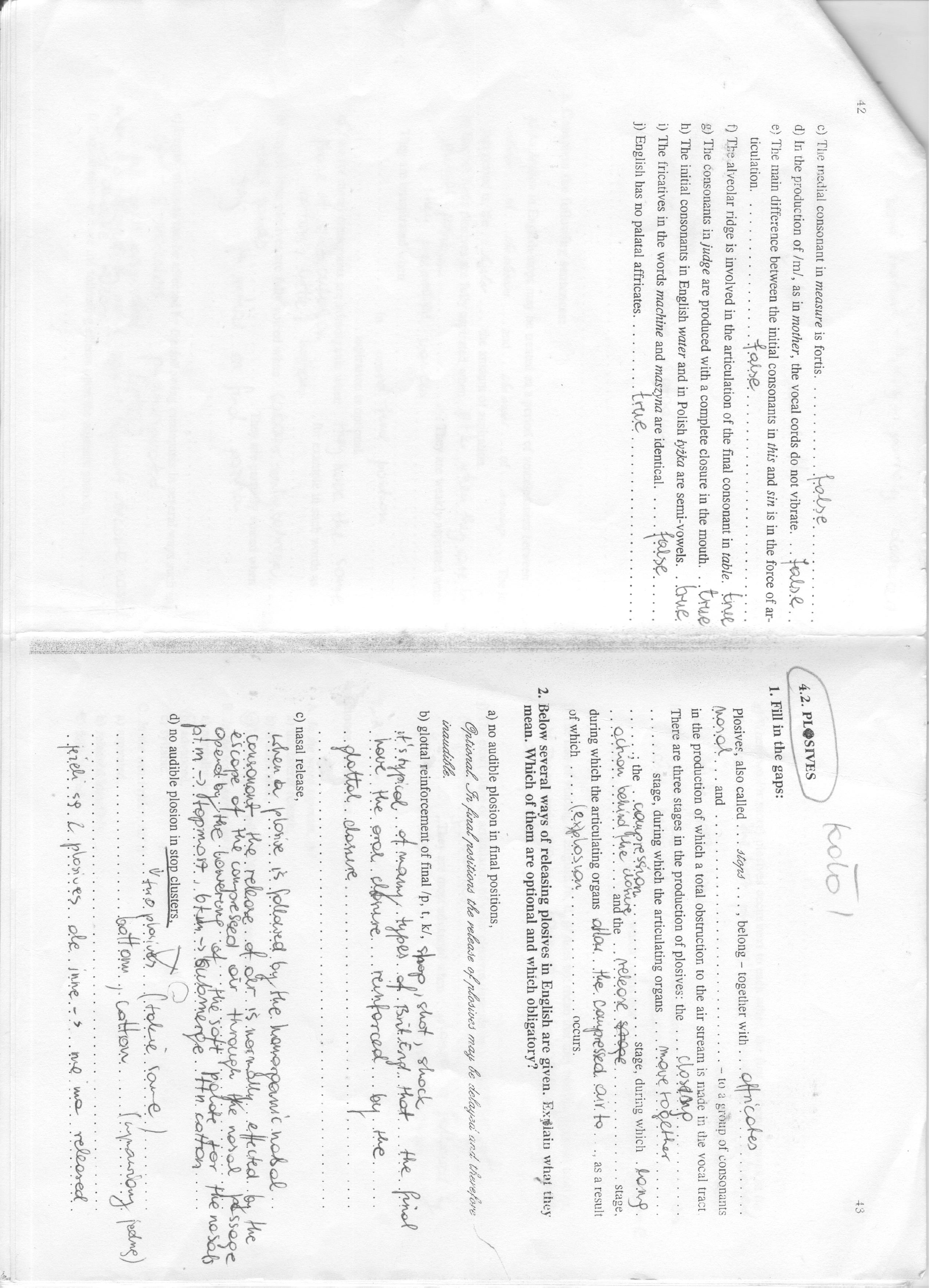plosives�1

42
c) The medial consonant in measure is fortis. . . ....................
d) In the production of /ml, as in mother, the vocal cords do not vibrate. . . . .
e) The main diffcrence between the initial consonants in this and sin is in the force of ar-
ticulation..... .......................................
f) The al/eolar ridge is involved in the articulation of the finał consonant in table.
g) The consonants in judge are produced with a complete closure in the mouth, .
h) The initial consonants in English water and in Polish łyżka are semi-vowels.
i) The fricatives in the words machinę and maszyna are identical...........
j) English has no palatal affricates. . . ............................
4.2. PL#SIVES
1. Fili in the gaps:
plosives, also called . . . dtcyu . . . , belong - together with . .
. . . and.............................- to a grńup of consonants
in the production of which a total obstruction to the air streara is madę in the vocai traci
There are three stages in the production of plosives: the . . . . .........
.......stage, during which the articulating organs . . . .......
......; the . ................stage, during which . £*C .vę .
^.^anJthe . . C^ęt. ..............stage.
during which the articulating organs oblew.. ,tW. C^uj?»eSfedL &.V. k> . ., as a result
of which...................occurs.
2. Below several ways of releasing plosives in English are given. Exjllain whal they mean. Which of them are optional and which obligatory?
a) no audible plosion in finał positions,
Ćfritto/iać ,Ja /v/fea<ie m-ay. /fe nktizj/sdas?.'/ t/fese/are
óiaeu/i&e.
b) glottal reinforcement of finał /p, t, k/, ) <ś/Locic
. .<?{ . jW-C/y.. .. 1M-.
. .0
. . Y**-. 979L . d^Urt. . . . ro/^^raiyd.. . . bt|. ......
c) nasal release,
utarte Hcg. tam*?.
'db. . reŁ<Ae . .Ą dr. is .Kor
(C ,V\X*A<a£.
.erjfcckd..
W. icor

^vyrou^£v. ff*
j,t „ s
d) no audible plosion in stop clusters, ^
ixJh-*Ł
u
Sj^n .)
m. tjW......[ f*^)
.peJU.L . olc.. iy&.r > .. rvv<3 . ?re^0^e9(
Wyszukiwarka
Podobne podstrony:
24 (580) 42 The Viking Age in Denmark being in the same position as Toke Gorm’s son. Only, it is per
fig1 A is the primary linę; «, the battery; the key. B te the secondary linę in which is placed the
The geomorphological mapping in Poland is not being restricted to the registration and the location
IB 4 1. Basic Head-lock Patterns Holding down the opponenfs head in a headlock is one, very popular
16 P. Anioła-Mikolajczak, Z. Gołaś Another factor affecting the saving ratę in households is their a
IMGP3175 Xeroderma pigmentosum The basie defect in XP is in nucleotide eicision repair (NER), leadin
30 mostly through the organization of the antenna complex. Indeed, the antenna complex in cyanobacte
Introduction The SDWP is a response to the challenges identified in the NSDC, providing for interven
DSCI3121 42 23. Which of the English consonants enumerated below have close equivalents in Polish: a
CCF20110611�059 Criterion-Referenced Test: A test in Which the performance of an individual is
52 (224) 98 The Viking Age in Denmark wali is of about the same size as the one at Aggersborg, measu
23 (42) The Fifteenth Day ofDecember 2 shuttles. The snowflake is madę in 2 rounds according to the
barbie14 CONSONANT SOUNDS Barbie and Kelly see a cat. Cat ends in the letter “t.” When Kelly is feel
więcej podobnych podstron